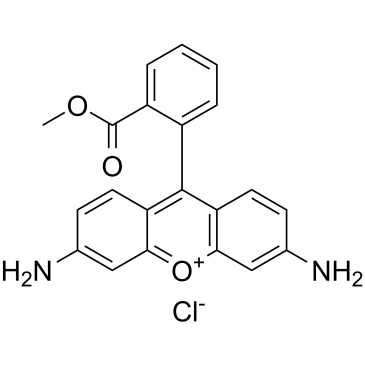| Cas No.: | 62669-70-9 |
| Chemical Name: | Xanthylium, 3,6-diamino-9-(2-(methoxycarbonyl)phenyl)-, chloride |
| Synonyms: | Rhodamine 123; R 22420; R 302; RH 123. |
| SMILES: | O=C(C1=CC=CC=C1C2=C3C=CC(N)=CC3=[O+]C4=C2C=CC(N)=C4)OC.[Cl-] |
| Formula: | C21H17ClN2O3 |
| M.Wt: | 380.828 |
| Purity: | 98% |
| Description: | Rhodamine 123 is a fluorescent dye (λex=503 nm, λem=527 nm). |
| In Vitro: | The intensity of R123 fluorescence has a peak at concentration of 50 μM, and decreases to zero at higher concentrations due to self-quenching[1]. |
| Kinase Assay: | Measurements are made at room temperature with continuous stirring of the mitochondrial suspension using spectrophotometer equipped with a magnetic stirrer with fluorescent cation R123 as probe. Excitation and emission wavelengths are 503 nm and 527 nm, respectively. The incubation medium is the respiration buffer. R123 and sodium pyruvate are added to final concentrations of 50 nM and 10 mM, respectively. Isolated mitochondria maintain a steady membrane potential (±5%) throughout the duration of the recording[1]. |
| References: | [1]. M. Huang, et al. Mitochondrial Inner Membrane Electrophysiology Assessed by Rhodamine-123 Transport and Fluorescence. Ann Biomed Eng. 2007 Jul; 35(7): 1276–1285. |

 To enhance service speed and avoid tariff delays, we've opened a US warehouse. All US orders ship directly from our US facility.
To enhance service speed and avoid tariff delays, we've opened a US warehouse. All US orders ship directly from our US facility.




















